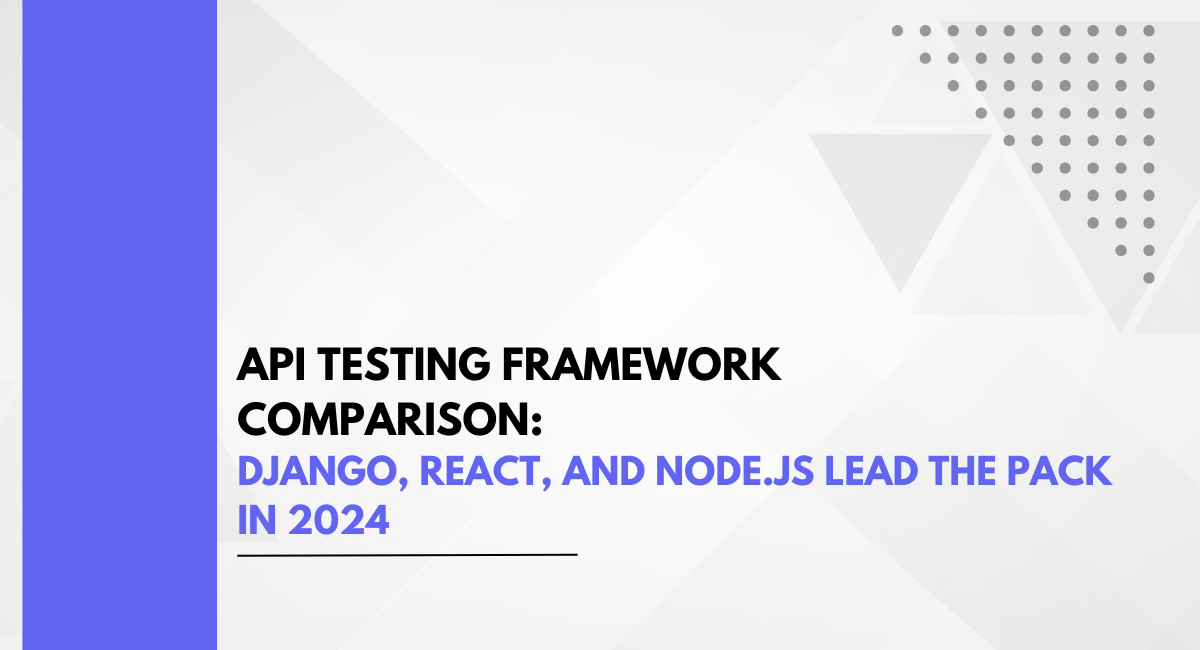Whether you're crafting the backbone of a cutting-edge mobile app or orchestrating the backend of a high-traffic website, understanding the best API testing frameworks is crucial. As we approach 2024, three stalwarts in this field—Django, React, and Node.js—are at the forefront, each boasting unique strengths that can make or break your project. Read API Testing Framework Comparison in this blog.
Django: The Backend Powerhouse
Django is a high-level Python web framework renowned for its rapid development capabilities and robust security features. It includes an integrated API framework that makes it easy to build RESTful APIs. Django's API testing framework leverages tools like Django Rest Framework (DRF), which provides built-in testing utilities that simplify the process of writing and running tests.
Key Features of Django's API Testing Framework:
- Built-in Testing Utilities: Django provides robust testing modules that come with built-in utilities for testing APIs.
- High-Level Abstractions: The framework offers high-level abstractions that simplify the process of writing tests, making it accessible even to developers who are not seasoned testers.
- Integration with Other Tools: It integrates well with other testing tools like Pytest and Unittest, providing flexibility in how you approach testing.
However, Django might not be the best choice for front-end heavy applications or those requiring a lighter-weight framework.
React: The Front-end Champion
React is a JavaScript library used for building user interfaces, particularly popular in the front-end development community. While React itself doesn't include an API testing framework out of the box, it can be integrated with various testing libraries to create comprehensive testing setups. Tools like Jest and Enzyme are commonly used in conjunction with React to handle API testing.
Key Features of React's API Testing Framework:
- Comprehensive Integration: React can be integrated with a wide range of testing libraries such as Jest and Enzyme, providing extensive options for testing.
- Component-Based Testing: React's component-oriented architecture makes it ideal for component-based testing, which is particularly useful when dealing with complex front-end applications.
- Community Support: The vibrant React community offers numerous resources and libraries that facilitate effective API testing.
However, setting up an API testing framework with React might require additional configuration and integration with other tools.
Node.js: The Lightweight Contender
Node.js is a server-side JavaScript runtime environment that has gained significant popularity in recent years due to its lightweight nature and high performance capabilities. Node.js can be used to build robust APIs and comes with several built-in modules that facilitate API testing. Popular testing frameworks like Jest and Mocha are commonly used with Node.js
Key Features of Node.js' API Testing Framework:
- Lightweight Architecture: Node.js' lightweight architecture makes it ideal for real-time data processing and microservices-based applications.
- Built-in Modules: Node.js provides several built-in modules like `http` and `https` that can be leveraged for testing purposes.
- Extensive Community Resources: The Node.js community offers a wide array of libraries and tools designed specifically for API testing.
However, Node.js might not be as intuitive for developers unfamiliar with JavaScript or server-side development.
API Testing Framework Comparison Summary
| Framework | Strengths | Weaknesses |
|---|
| Django | High-level abstractions, built-in testing utilities, seamless integration with other tools. | Heavyweight architecture, might not be ideal for front-end applications. |
| React | Comprehensive integration with testing libraries, component-based testing, vibrant community support. | Requires additional configuration for API testing setup. |
| Node.js | Lightweight architecture, built-in modules for testing, extensive community resources. | Might be challenging for developers unfamiliar with JavaScript or server-side development. |
Each framework has its unique strengths and weaknesses that make them suitable for different types of projects. Django excels in backend development with its robust built-in testing utilities but might fall short in front-end heavy applications. React offers comprehensive testing capabilities through its integration with various libraries but requires additional configuration for API testing setup.
Node.js provides a lightweight architecture ideal for real-time data processing and microservices but may pose challenges for developers new to JavaScript. The choice between these frameworks is not about which one is better but about which one best aligns with your project's unique requirements.
Whether you're building a complex web application with Django's structured approach, a dynamic single-page app with React's agility, or a real-time system with Node.js's scalability—each framework offers unparalleled capabilities in its own right. Understanding these frameworks is crucial for developers looking to harness the power of API testing and create seamless, high-performance applications.
Recommended Resources
- Django Documentation: Django Rest Framework
- React Documentation: Jest and Enzyme
- Node.js Documentation: Jest and Mocha
By leveraging the strengths of each framework—whether it's Django's high-level abstractions, React's comprehensive integration with testing libraries, or Node.js' lightweight architecture—developers can ensure their applications meet the highest standards of quality and performance in 2024 and beyond.
You may also be interested in: 32 Best Web Development Frameworks for 2024 | ContextQA
Book a Demo and experience ContextQA testing tool in action with a complimentary, no-obligation session tailored to your business needs.
We make it easy to get started with ContextQA tool: Start Free Trial.
